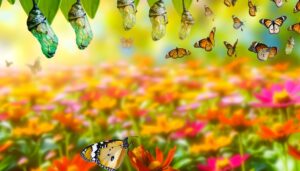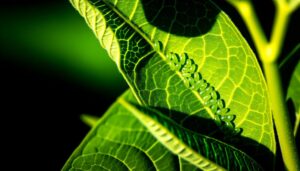How to Feed a Monarch Butterfly: Complete Guide
Feeding a monarch butterfly requires a keen understanding of its lifecycle and nutritional needs. Monarch caterpillars exclusively consume milkweed (genus Asclepias), which supplies essential proteins, carbohydrates, and toxins for defense.
Adult monarchs feed on nectar from sources like milkweed, goldenrod, and coneflowers. Nectar provides crucial energy, particularly important during migration.
To support monarch populations, consider planting diverse nectar-rich flowers and creating butterfly-friendly habitats. Regularly cleaning feeders and preparing nectar solutions like sugar water (4:1 water to sugar ratio) can enhance feeding success.
Such efforts are fundamental to sustaining monarchs, revealing more about effective conservation strategies.
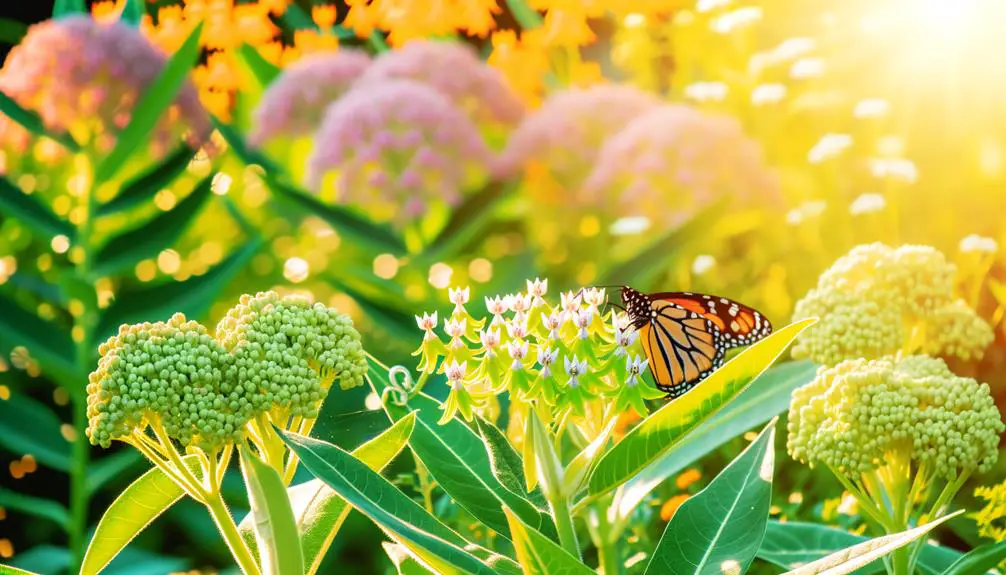
Key Takeaways
- Monarch butterflies primarily feed on nectar from flowering plants such as milkweed, coneflowers, and goldenrod.
- Supplementary feeding can be done using a sugar-water solution with a 4:1 water-to-sugar ratio.
- Ensure feeders are placed in shaded, wind-protected areas to prevent overheating and disturbances.
- Regularly clean and refill feeders every 2-3 days to maintain hygiene and availability.
Life Cycle Stages
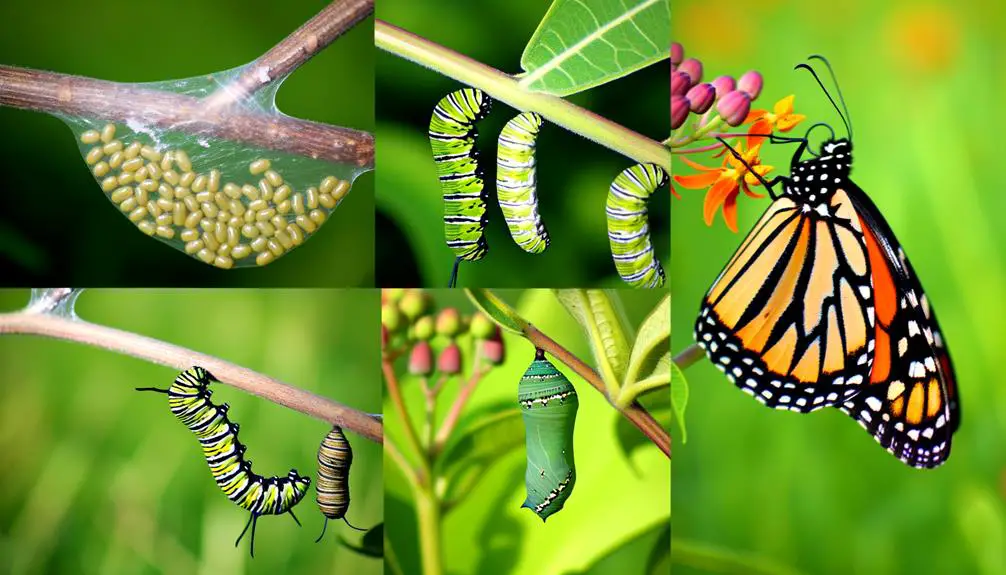
The life cycle of a monarch butterfly, Danaus plexippus, consists of four distinct stages: egg, larva (caterpillar), pupa (chrysalis), and adult butterfly. Each stage represents a vital phase in the development and survival of the species.
The journey begins when a female lays her eggs, typically on milkweed plants. These eggs hatch into larvae, which undergo several molts, growing exponentially in size.
Following the larval stage, the caterpillar forms a chrysalis, within which it undergoes metamorphosis. This transformative process culminates in the emergence of an adult butterfly, characterized by its striking orange and black wings.
Each stage is intricately linked, ensuring the continuation of the species, and understanding these stages is essential for effective conservation efforts.
Caterpillar Diet
Monarch caterpillars, during their larval stage, exclusively consume the leaves of milkweed plants (genus Asclepias), which provide the necessary nutrients and chemical defenses for their growth and survival.
The milkweed diet is essential for several reasons:
- Nutrient Supply: Milkweed leaves offer essential proteins, carbohydrates, and lipids.
- Chemical Defense: The cardenolides in milkweed make caterpillars distasteful to predators.
- Growth Facilitation: Continuous leaf consumption supports rapid growth and molting.
- Habitat Provision: Milkweed serves as both food source and habitat.
This specialized diet enables monarch caterpillars to develop into healthy, robust butterflies, demonstrating the intricate relationship between these insects and their host plants.
Importance of Milkweed
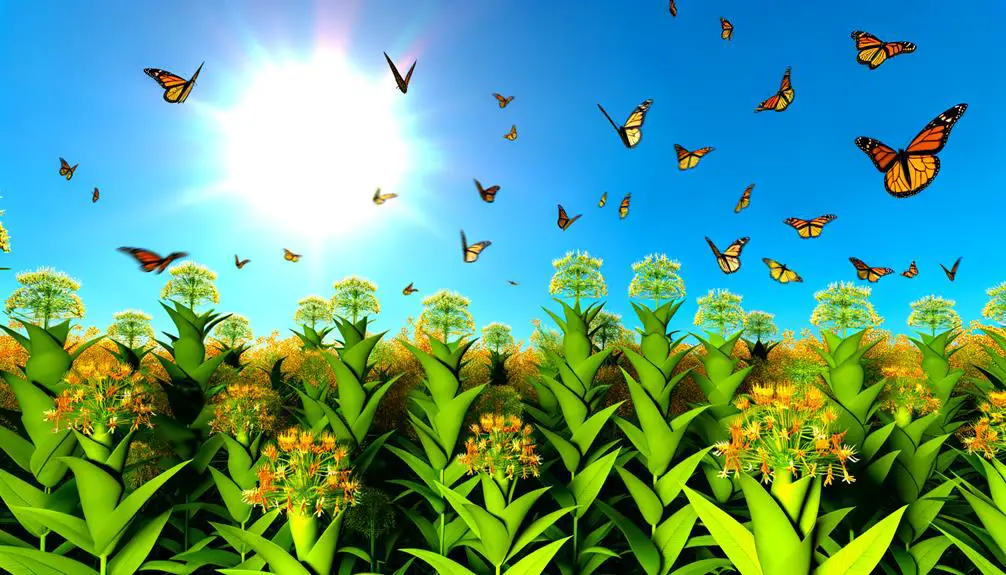
Milkweed is an essential component of the monarch caterpillar's diet, serving as its primary food source and providing critical nutrients for growth and development.
Additionally, preserving milkweed habitats is important for the survival of monarch populations, as it supports both larval and adult stages.
As a result, the conservation of milkweed is essential for maintaining healthy ecosystems and ensuring the continuity of the species.
Monarch Caterpillar Diet Staple
Essential to the diet of monarch caterpillars, milkweed provides not only the primary food source but also critical chemical compounds for their survival and development. The consumption of milkweed leaves is fundamental for several reasons:
- Nutrient Supply: Provides essential nutrients necessary for growth.
- Cardenolides: Contains toxins that make caterpillars distasteful to predators.
- Exclusive Diet: Monarch caterpillars are oligophagous, feeding solely on milkweed.
- Development: Supports all larval stages from hatching to pupation.
Understanding the importance of milkweed in the diet of monarch caterpillars is significant for fostering their lifecycle.
The unique relationship between the monarch and milkweed underscores the necessity of preserving this plant species.
Habitat Preservation Necessity
Preserving the natural habitats that support milkweed growth is essential for the survival and proliferation of monarch butterflies. Milkweed is the sole host plant for monarch larvae, providing important nutrients for their development. Habitat destruction, largely due to agricultural expansion and urbanization, poses a significant threat to milkweed availability. This reduction adversely impacts monarch populations, leading to their decline.
| Threat | Impact on Milkweed | Consequence for Monarchs |
|---|---|---|
| Urbanization | Habitat Loss | Reduced Breeding Grounds |
| Pesticides | Plant Mortality | Decreased Larval Survival |
| Climate Change | Altered Growth Patterns | Disrupted Life Cycles |
Ensuring the preservation and restoration of milkweed habitats is essential. Conservation efforts, such as creating butterfly-friendly gardens and protecting native plant species, are important strategies to support monarch populations.
Adult Butterfly Diet
Adult monarch butterflies primarily sustain themselves on nectar from various flowering plants, with a preference for nectar-rich varieties such as milkweed, coneflowers, and goldenrods.
These flowers provide essential nutrients that are critical for energy, especially during migration.
The ideal feeding time for monarchs is during warm, sunny periods when flowers are most productive in nectar secretion.
Nectar-Rich Flower Varieties
Monarch butterflies primarily rely on nectar from a variety of flowering plants, which are vital for their sustenance and energy needs during migration and reproduction. Selecting nectar-rich flowers can greatly impact their survival and overall health.
Notable varieties include:
- Milkweed (Asclepias spp.): The primary host and nectar source, critical for monarchs' lifecycle.
- Coneflowers (Echinacea spp.): Provide substantial nectar and are known for their long blooming period.
- Lantanas (Lantana spp.): Offer abundant nectar and thrive in warm climates, making them ideal for migratory paths.
- Zinnias (Zinnia spp.): Easy to grow and attract monarchs with their bright, nectar-rich blooms.
These species collectively support monarchs' dietary needs and migration success.
Ideal Feeding Time
Understanding the ideal feeding times for adult monarch butterflies is equally important as selecting the right nectar-rich flowers to guarantee their energy needs are met efficiently.
Monarch butterflies are most active during daylight, with peak feeding occurring in the mid-morning and early afternoon. These periods coincide with prime nectar flow from flowers, maximizing energy intake.
Monitoring local weather patterns is vital; warm, sunny days enhance nectar availability, while overcast or rainy conditions may inhibit feeding behavior.
Additionally, monarchs exhibit increased feeding activity before migration or breeding periods, necessitating abundant nectar sources during these significant times.
Ensuring an uninterrupted supply of suitable flowers during these key feeding windows supports their energetic and reproductive requirements, promoting robust monarch populations.
Nectar Sources
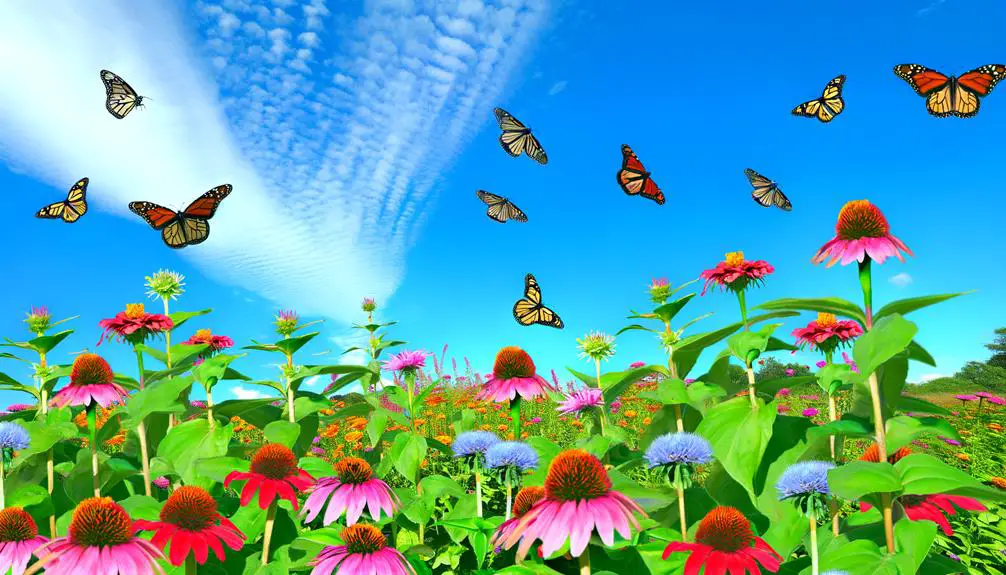
To sustain their energy for migration and reproduction, monarch butterflies primarily rely on a variety of nectar sources from specific flowering plants. These nectar sources are essential for providing the necessary carbohydrates that fuel their long journeys and reproductive activities. Monarchs prefer flowers that offer high nectar yield and are easily accessible.
Key nectar sources include:
- Milkweed (*Asclepias spp.*): The primary host plant for monarchs, also a critical nectar source.
- Goldenrod (*Solidago spp.*): Abundant in late summer and fall, important for migrating monarchs.
- Blazing Star (*Liatris spp.*): Offers high nectar content, attracting numerous butterflies.
- Coneflowers (*Echinacea spp.*): Rich in nectar, supports various pollinators.
Selecting these plants guarantees monarch butterflies receive peak nourishment.
Supplementary Feeding Tips
For those looking to support monarch butterflies beyond natural nectar sources, providing supplementary feeding stations can be an effective strategy. These stations can be simple yet essential for guaranteeing that monarchs receive the necessary nutrients during migration or when natural resources are scarce. Use a sugar-water solution, ideally composed of four parts water to one part sugar, mimicking natural nectar. Ascertain the feeder is clean and free from mold, as contaminants can harm butterflies.
| Feeding Tip | Details |
|---|---|
| Sugar-Water Ratio | 4 parts water to 1 part sugar |
| Feeder Hygiene | Clean regularly to prevent mold |
| Placement | Position in a shaded, wind-protected area |
| Refill Frequency | Every 2-3 days or as needed |
| Observation | Monitor for signs of excessive consumption |
These practices will help maintain a healthy monarch population.
Creating a Butterfly-Friendly Habitat
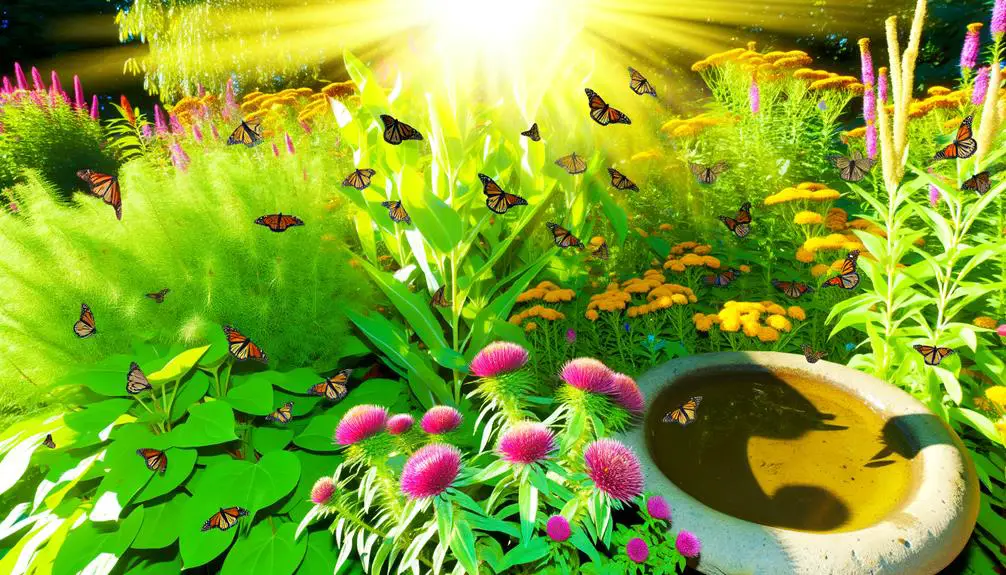
Beyond providing supplementary feeding stations, establishing a butterfly-friendly habitat is fundamental for supporting monarch butterflies throughout their lifecycle. This habitat should cater to their needs at every stage, from egg to adult.
Key elements include:
- Milkweed Plants: Essential for monarch caterpillars, as they serve as the sole food source.
- Nectar Sources: Diverse flowering plants that bloom at different times to guarantee a continuous nectar supply.
- Shelter: Dense shrubs and trees to offer protection from predators and harsh weather.
- Water Features: Shallow water sources or damp areas for hydration.
Creating such an environment encourages monarch survival and supports their natural migratory patterns.
Conclusion
The dietary requirements of monarch butterflies are as essential to their survival as the strings of a violin are to its melody.
The larval dependence on milkweed for critical nutrients mirrors the specialized needs of adult butterflies for nectar-rich sources.
Research underscores the necessity of curated habitats to support their life cycle stages.
For instance, a study found that monarch populations increased by 70% in areas with abundant milkweed.
This illustrates the symbiotic relationship between flora and fauna in ecological preservation.


